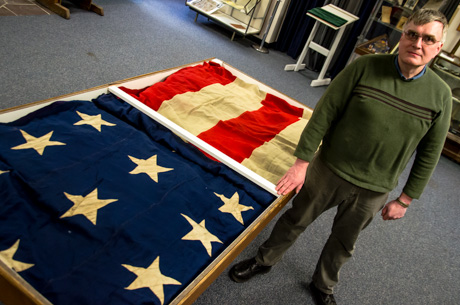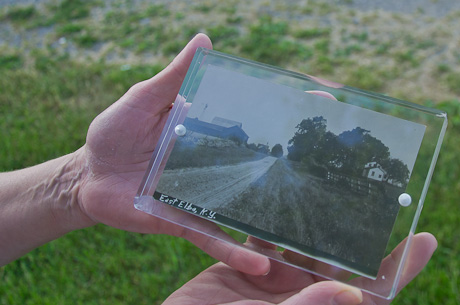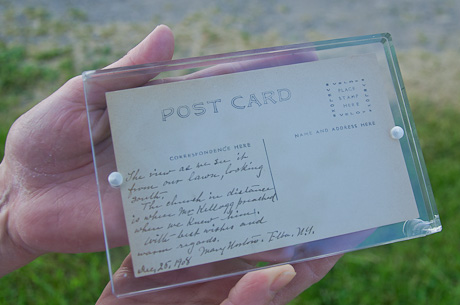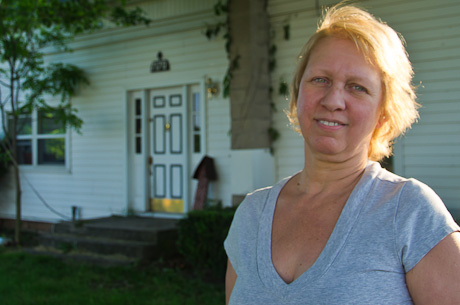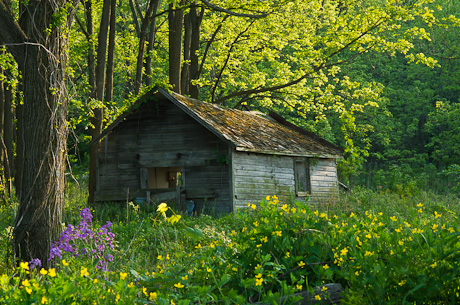Le Roy's Holy Family School closed its doors for the last time a couple of weeks ago, but the school will long be remembered for the outstanding staff and students who graced its hallways and classrooms, for the positive community atmosphere it enjoyed, and for what it meant to local families during its 123-year history.
Photo courtesy of Kelly Hansen
There were 10 students in the final graduating class of the school at 46 Lake St., which was attached to Our Lady of Mercy Parish and served pupils in pre-K through eighth-grade. Students came not only from Le Roy, but also from elsewhere in Genesee County as well as Wyoming, Livingston and Monroe counties.
Photo courtesy of the Le Roy Historical Society
The school has seen a lot of changes -- including a change in its name -- since it was first staffed by the Sisters of Mercy more than 120 years ago (see the timeline of milestones at the end of this story). Throughout all of these changes, its tradition of academic excellence and thriving school family remained much the same.
People who were part of the Holy Family community are filled with sadness, but also with fond memories and hope for the future.
Here are some stories that give an idea of just how special a place Holy Family was:
Michael Ficarella
Michael Ficarella, of Batavia, was hired as a sixth- through eighth-grade teacher at Holy Family School for the 2011-2012 school year. It was his first full-time teaching job.
"I couldn't have picked a better school to start (teaching)," Ficarella said.
He talked about the supportive team of teachers who welcomed and helped him throughout the year.
"From real early on, they were always coming by my room to see how I was doing, offering pointers on how to make this or that lesson better or how to make the classroom run smoother, etcetera."
In addition to teaching science and social studies, Ficarella also worked with younger students in the school's after-school program. During his brief time at Holy Family, he got to know a lot of kids.
"The students were great," he said. "They were well-mannered, very eager to learn and took pride in their school."
He mentioned the eighth-grade field trip to Washington, D.C., on which the kids were "phenomenal."
Despite losing his job his first year teaching, Ficarella said he is "absolutely 100 percent" glad of the experience and has no regrets.
The Hansen Family
Photo courtesy of Kelly Hansen
One of Ficarella's students was Alex Hansen, who was part of Holy Family School's final graduating class. He attended the school from kindergarten through eighth-grade.
"(The graduation) was bittersweet," said Kelly Hansen, Alex's mother. "What we were witnessing was never to take place at Holy Family School ever again."
"There were many 'lasts' over the past few months. It was very difficult for everyone as the adults tried to make the last days of school the best they could possibly be."
Hansen said that the decision she and her husband made to send Alex to Holy Family was "curious to some because we live in Batavia."
"The answer is never an easy one," she said, "but it always contains the same elements. The high test scores, great word-of-mouth, a place where God could be mentioned without fear of ridicule, not to mention a stellar reputation within the community for more than one hundred years."
She and her husband were also impressed with the parish to which the school was connected, which was called St. Peter's at the time.
"I'm not sure there would be a way to calculate the grand sum from the parish that has kept the school afloat for 123 years," she said.
Photo courtesy of Our Lady of Mercy Parish Secretary Sue Bobo
Of course, the school environment was also a major factor in the decision.
"We were impressed with what we saw the day we first visited," Hansen said. "Children holding the door for us as we came and went, walking down the halls and having students greet us without an adult to prompt them, students standing and greeting adults as they entered a classroom -- all this left us knowing that we were making the right decision for our family."
Second-grade teacher Patty Page is pictured with her granddaughter at a Halloween party at Holy Family School. Photo courtesy of Sue Bobo.
As for the teachers, their "commendable dedication" has left an impression on Hansen.
"Many teachers at (Holy Family School) have taught for 20 or more years," she said. "Catholic school teachers are state certified yet make a small fraction of what their public school counterparts do. They clearly are not in their chosen profession for the money -- it is something they do because they love it."
She sees this as part of a pattern of sacrifices that everyone involved in the Catholic school system makes for what they consider the greater good.
"Most families who choose to send their children to a Catholic school quietly go without things other families take for granted so that their children may reap the abundant benefits," she said.
"We’ve had the same car over the course of all nine years (of Alex attending Holy Family School). It is a bit rustier and a lot noisier. It has driven from Batavia to Le Roy hundreds of times, often carrying multiple students to one event or another."
"To pay for education that could otherwise be obtained for free at a public school is a bizarre choice to some," she said. "But for us it was the only option we could imagine. Anyone familiar with Catholic education knows about the sacrifices made in order for it to be possible."
The Winters Family
Photo courtesy of Bryan Winters
When first-grader Anna Rose Winters learned that her school would be closing, she was very sad. But then the first question that came out of her mouth was: "What are the uniforms like at St. Joe's?"
Anna Rose, like other Holy Family students, will attend St. Joseph School in Batavia in the fall.
"She went through the normal grief stages," said her father, Bryan Winters. "There were tears, but then she very quickly started to incorporate St. Joe's."
Winters was on Holy Family School's Finance Committee for several months, which put Anna Rose in a "unique situation."
"She's a smart kid -- she could read the writing on the wall," he said. "We were honest with her from the beginning that her school could close, but we'd try our best."
And try they did. According to Winters, who makes his living raising money for the University of Rochester School of Medicine and Dentistry, the committees formed by parents to help save the school "were doing all the right things."
"It's remarkable how much money we were able to raise with the time constraint," he said. "But there were a lot of needs-based scholarships (and other expenses that could not be met with the current student enrollment)."
Like his daughter, Winters also went through the grieving process. But he has a "very great feeling" about St. Joe's and is optimistic about Anna Rose's future.
"(Of course), there are families who have been at Holy Family for three or four generations," he said. "Their grieving process is probably longer, and that's understandable. But I need to think of the best interests of my daughter. We're going to get fully involved in St. Joe's."
Bryan and Kate Winters moved to Le Roy from Monroe County a few years ago. Holy Family School was the main reason for their move.
Having just started a family, they wanted to move to the country to give their kids (they have two younger children in addition to Anna Rose) some "breathing room." But they also wanted to make sure the kids received a Catholic education.
"We looked around Western New York and the Finger Lakes region," Winters said. "We toured different schools in Livingston and Monroe counties, and even some in Erie County."
They were very selective in their search, because everything in their lives is a "distant second to our kids."
When they went to an open house at Holy Family, "that sealed the deal."
"That was where we knew we felt at home (at Holy Family)," Winters said. "We learned about the different programs and the curriculum -- they had a very rigorous program. We liked the student-teacher ratio. It was primarily for that reason that we moved to Le Roy."
With three years as a Holy Family parent under his belt, Winters still sings the school's praises loudly.
"It blows my mind that there were people around here who didn't send their kids to Holy Family," he said. "They must not have known what we had there."
Pictured Principal Kevin Robertson with Mrs. Page's second-grade class. Photo courtesy of Sue Bobo.
Like Ficarella and Hansen, he touted the supportive atmosphere the school offered.
"We could call or email any time, and (the issue) was taken care of," he said. "There was a real family feel, whether it was students with teachers or families with teachers. It was an open community."
Part of this openness was the teachers' willingness to share personal stories with their students.
"Every once in a while Anna Rose would share a story at dinner about a teacher's dog, or about Mrs. So-and-So's son getting into a certain college," Winters said. "The fact that these teachers would recognize (for example) that a first-grader wants to hear stories about a dog means a lot. It goes back to that feeling of family."
Winters' wife is a teacher, so the two of them "have a pretty good pulse on what a good teacher is."
"And these teachers -- they had it," he said.
And the students weren't bad, either.
"The Holy Family slogan was 'Teaching Tomorrow's Leaders,' and I think that's what they were doing," Winters said.
He commented on how the kids would hold doors for people and demonstrate politeness in other ways.
"All that stuff goes above and beyond two plus two," he said. "It was about more than just standardized testing; the focus was on growing the student as a person. It was built into the curriculum."
Anna Rose is excited about going to St. Joe's, but she and her family will always have fond memories of Holy Family School.
STORY CONTINUES after the jump (click the headline to read more):
A Brief History in Pictures
Holy Family's original name was St. Peter's School, after the church with which it was affiliated (St. Peter's Church became Our Lady of Mercy Parish in 2008). The school was placed in the charge of the Sisters of Mercy, who lived in Batavia and commuted every day by train the first year.
A photo of St. Peter's academic department in the early 1900s. Photo courtesy of the Le Roy Historical Society, originally published in the Le Roy Gazette.
St. Peter's grew significantly between its founding in 1889 and 1955, when it was expanded to serve the children of both Catholic parishes in Le Roy (the other one being St. Joseph's Church). At that point, it was renamed "Holy Family School."
Note: Unless otherwise specified, all of the following were published in the Batavia Daily News and obtained courtesy of the Le Roy Historical Society:
Photo published in the Holy Family School Newsletter
Over the years, Holy Family slowly made the transition from a parochial school to a regional school. Hansen said that by the time it closed, "only 40 percent of the students were from Le Roy, with remaining students coming from Wyoming, Livingston and Monroe counties."
Regional schools have different requirements than parochial schools, including, according to Hansen, a "suggested class size (of) 20-25 students per grade level."
Take that, the fact that the school was staffed by state certified teachers instead of religious sisters receiving a modest stipend (which kept tuition costs low), and the population decrease in our area, and you get a good idea of the reason for Holy Family School's closure.
For more information on Holy Family School's history, please see the timeline at the bottom of this story.
Here are some pictures of the school through the years, courtesy of Sue Bobo and the Le Roy Historical Society:
Graduating class of 1957
Graduating class of 1965
Graduating class of 1978
Thank you to the interviewees, Sue Bobo and the Le Roy Historical Society for the information and pictures.
Timeline: Holy Family School:
-
1849 -- Rev. Edward Dillon founds St. Peter's Catholic Church in Le Roy.
-
1852 -- Rev. Thomas Fitzgerald, Rev. Dillon's successor as pastor, begins collecting funds to enlarge parish in response to rapid membership growth.
-
1857 -- Temporary parish school established by Rev. James McGlew in the church basement.
-
July 1889 -- Work is begun on new school behind St. Peter's Church (now called "the annex").
-
Sept. 2, 1889 -- St. Peter's School opens, with the Sisters of Mercy recruited to teach.
-
Early 1900s -- St. Peter's School has enrollment of 260 students.
-
Feb. 14, 1907 -- Most Rev. Charles H. Colton, bishop of Buffalo, administers Sacrament of Confirmation in Le Roy; large number of Italian-American residents ask for their own "National" (or ethnic) parish.
-
Feb. 16, 1907 -- Bishop Colton sends Rev. Joseph A. Gambino to establish St. Joseph's Church.
-
1913 -- Significant improvements to St. Peter's Church and School.
-
1955 -- St. Joseph's and St. Peter's unite to build a new school building to serve all Catholic children in Le Roy. Upon completion, St. Peter's School is renamed Holy Family School.
-
Sept. 23, 1956 -- Holy Family School is officially dedicated by Most Rev. Leo R. Smith, an auxiliary bishop of the Diocese of Buffalo.
-
1965 -- Gymnasium is built in the school.
-
1989 -- Holy Family School is run mostly by laypeople rather than nuns.
-
1993 -- Barbara McVean becomes the first layperson to serve as principal of Holy Family School.
-
1990s -- 2000s -- Holy Family School begins to serve students from other communities as neighboring Catholic schools close. Children from elsewhere in Genesee County as well as from Wyoming, Livingston and Monroe counties attend the school.
-
2008 -- St. Joseph's and St. Peter's merge as Our Lady of Mercy Parish.
-
2009 -- 2010 -- Under diocesan plan, Holy Family School transitions from parochial to regional school.
-
2011 -- Parents establish the Holy Family School Finance/Fund Raising Committee to try saving the school from closure.
-
2012 -- Holy Family School closes in spite of valiant student, parent and teacher efforts.
-
June 8, 2012 -- The Holy Family School Choir performs for the last time in public at the Le Roy Bicentennial Celebration; receives standing ovation.
Previous coverage of Holy Family School:
Mancuso's hosts Holy Family School, of Le Roy, for Catholic Schools Week
Pictures: Holy Family and St. Joe's kids
Students at Holy Family learning and having fun with art

